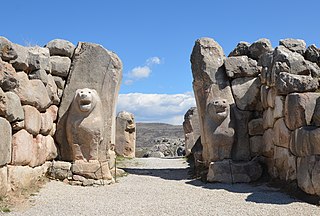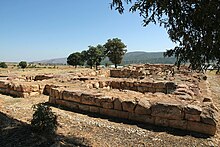
The Hittites were an Anatolian Indo-European people who formed one of the first major civilizations of Bronze Age West Asia. Possibly originating from beyond the Black Sea, they settled in modern-day Turkey in the early 2nd millennium BC. The Hittites formed a series of polities in north-central Anatolia, including the kingdom of Kussara, the Kanesh or Nesha kingdom, and an empire centered on Hattusa. Known in modern times as the Hittite Empire, it reached its peak during the mid-14th century BC under Šuppiluliuma I, when it encompassed most of Anatolia and parts of the northern Levant and Upper Mesopotamia, bordering the rival empires of the Hurri-Mitanni and Assyrians.
Hattic, or Hattian, was a non-Indo-European agglutinative language spoken by the Hattians in Asia Minor in the 2nd millennium BC. Scholars call the language "Hattic" to distinguish it from Hittite, the Indo-European language of the Hittite Empire. The Hittites referred to the language as "hattili", related to the Assyrian and Egyptian designation of an area west of the Euphrates as "Land of the Hatti" (Khatti).

Hattusa, also Hattuşa, Ḫattuša, Hattusas, or Hattusha, was the capital of the Hittite Empire in the late Bronze Age during two distinct periods. Its ruins lie near modern Boğazkale, Turkey, within the great loop of the Kızılırmak River.
Muršili III, also known as Urhi-Teshub, was a king of the Hittites who assumed the throne of the Hittite empire at Tarhuntassa upon his father's death. He was a cousin of Tudhaliya IV and Queen Maathorneferure. He ruled ca. 1282–1275 BC or 1272–1265 BC.
Arnuwanda I was a Hittite great king during the early 14th century BC, ruling in c. 1390–1380/1370 BC.

Hittite mythology and Hittite religion were the religious beliefs and practices of the Hittites, who created an empire centered in what is now Turkey from c. 1600–1180 BC.
Ortaköy is a town in Çorum Province in the Black Sea region of Turkey, located at 57 km from the city of Çorum. It is the seat of Ortaköy District. Its population is 2,033 (2021). The mayor is Taner İsbir (AKP).

Tudḫaliya III, with the additional Hurrian name Tašmi-Šarri, was a Hittite great king in Anatolia during the Late Bronze in the 14th century BC, in c. 1380–1350 BC. He was the son and successor of Arnuwanda I and the predecessor, father-in-law, and adoptive father of Šuppiluliuma I.
The Kaska were a loosely affiliated Bronze Age non-Indo-European tribal people, who spoke the unclassified Kaskian language and lived in mountainous East Pontic Anatolia, known from Hittite sources. They lived in the mountainous region between the core Hittite region in eastern Anatolia and the Black Sea, and are cited as the reason that the later Hittite Empire never extended northward to that area. They are sometimes identified with the Caucones known from Greek records.

Maşat Höyük is a Bronze Age Hittite archaeological site 100 km nearly east of Boğazkale/Hattusa, about 20 km south of Zile, Tokat Province, north-central Turkey, not far from the Çekerek River. The site is under agricultural use and is plowed. It was first excavated in the 1970s.

Nerik was a Bronze Age settlement to the north of the Hittite capitals Hattusa and Sapinuwa, probably in the Pontic region. Since 2005–2009, the site of Nerik has been identified as Oymaağaç Höyük, on the eastern side of the Kızılırmak River, 7 km (4.3 mi) northwest of Vezirköprü.

Šamuḫa is an ancient Bronze Age settlement near the village of Kayalıpınar, Yıldızeli, c. 40 km west of Sivas, in the Sivas Province of Turkey. Located on the northern bank of Kizil Irmak river, it was a city of the Hittites, a religious centre and, for a few years, a military capital for the empire. Samuha's faith was syncretistic. Rene Lebrun in 1976 called Samuha the "religious foyer of the Hittite Empire".

Zalpuwa, traditionally also thought to be Zalpa, was a still-undiscovered Bronze Age city in Anatolia of around the 18th century BC. Its history is largely known from the Proclamation of Anitta, CTH 1. It has now been proposed that the Zalpa mentioned in the Annals of Hattusili I, CTH 4, was a different city located at Tilmen Höyük, in the Karasu River Valley south of the Taurus Mountains by Tubingen and Chicago Universities recent excavations.
Zippalanda was a Hattic administrative and religious center of the Hittite Old Kingdom. Although its name was known from inscriptions, it was not until the latter 20th century that scholars placed it in Sorgun District of Yozgat Province, Turkey, near Kerkenes Dağ, about one day's journey north of Ankuwa.
Ḫalki was the Hittite deity of grain. While it is commonly assumed the name consistently referred to a goddess, a male form of this deity has also been identified. Ḫalki was associated with other grain deities, namely Mesopotamian Nisaba and Hattian Kait, with the latter presumed to be functionally identical. The oldest attestations come from Kanesh, though they are limited to theophoric names. In later periods, the female form of Ḫalki was worshiped in Hattusa, and the male one in Nerik, though evidence from other cities is also available.
Šulinkatte was a Hittite god of Hattian origin. He was regarded as a war deity. Additionally, he could fulfill the role of a protector of palaces and houses. In the local tradition of Nerik, he was regarded as the father of the weather god of Nerik. He first appears in texts dated to the fifteenth or fourteenth century BCE. His main cult center was the sparsely attested city Tamarmara, but he was also worshiped elsewhere in ancient Anatolia, for example in Hattusa and Nerik. Fragments of a Hattic song celebrating him are also known.
Wurunkatte or Wurukatte was a Hittite war god of Hattian origin. He might have also been connected to the institution of kingship. His symbol was a mace, and based on textual sources it is presumed he could be depicted standing on the back of a lion. Inhe appears in association with deities such as Šulinkatte, Taru and Telipinu. He was worshiped in Hattusa, Nerik, Tuḫumijara and Tarammeka.
Kataḫḫa or Kataḫḫi was a name or title of multiple goddesses worshiped in ancient Anatolia by Hattians and Hittites, with the best known example being the tutelary deity of Ankuwa. It has been proposed that goddesses sharing this name were associated with nature and wildlife.
Kataḫzipuri was a goddess worshiped by Hattians, Hittites and Palaians in Bronze Age Anatolia. She was associated with magic, and was commonly invoked in rituals dealing with healing and purification. She was closely associated with Kamrušepa. In Palaic religion she formed a pair with Ziparwa and headed the pantheon alongside him.

The Wars of Survival were a series of wars between the Hittite Empire and its neighbours including Arzawa, Kaška, and Hayasa-Azzi. The wars, which lasted from c. 1400 BC to 1350 BC proved to be an existential period for the Hittites, whose capital city of Ḫattuša was sacked and whose territory was reduced to a small area around Šamuḫa. However, the Hittite general and future king Šuppiluliuma regained all of their lost territory and embarked on punitive expeditions which firmly reestablished the Hittites as a major power.













